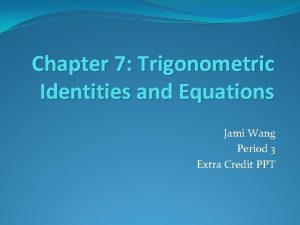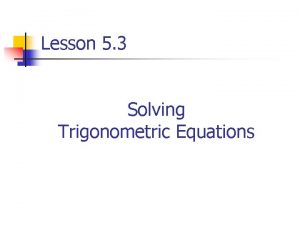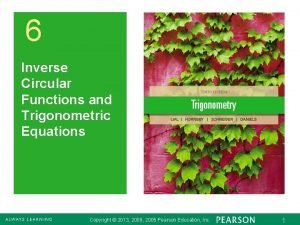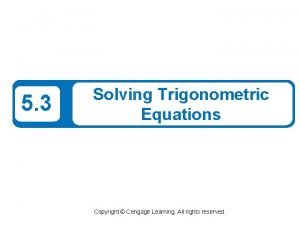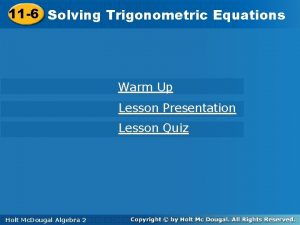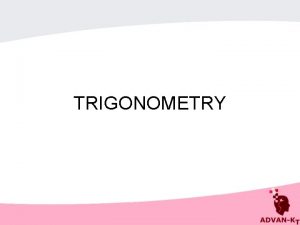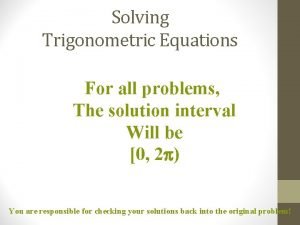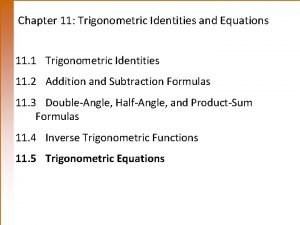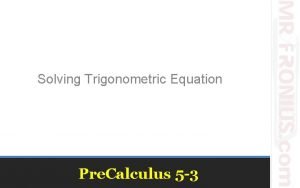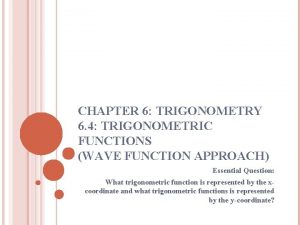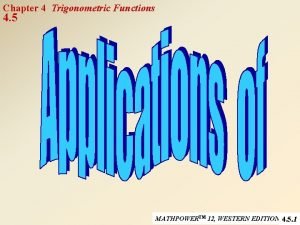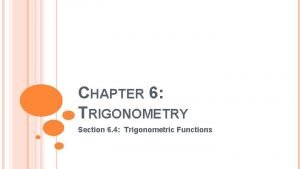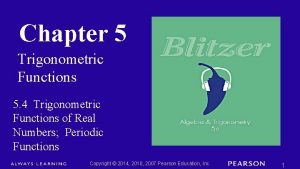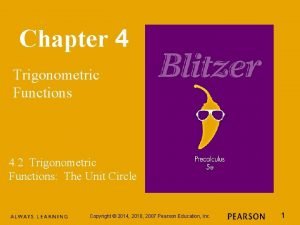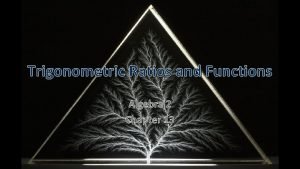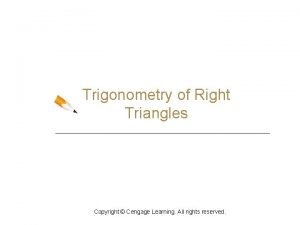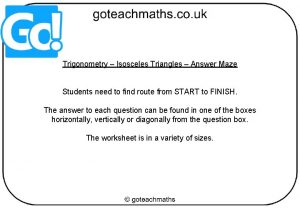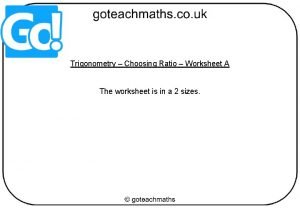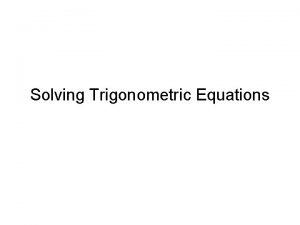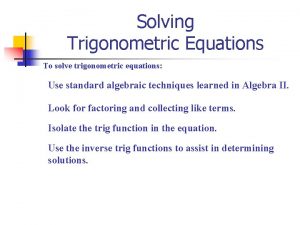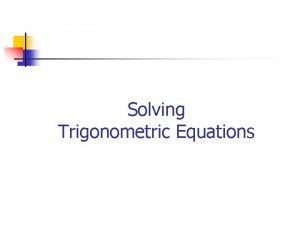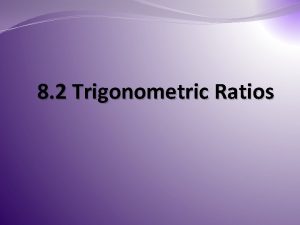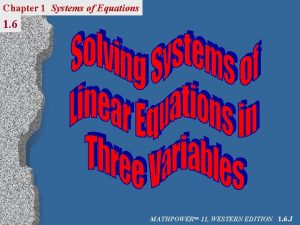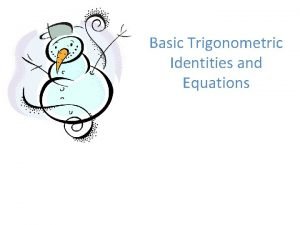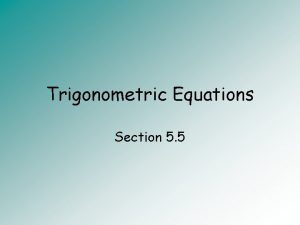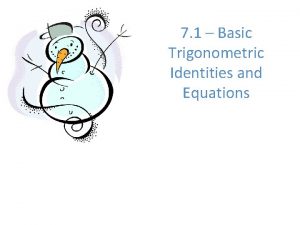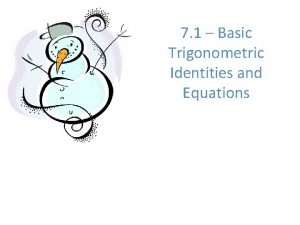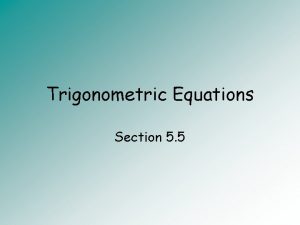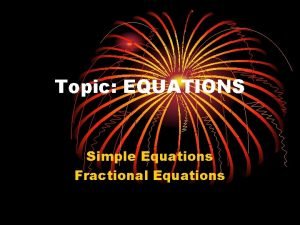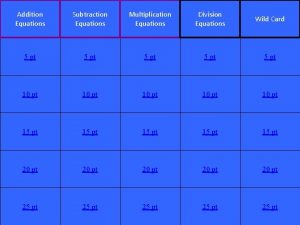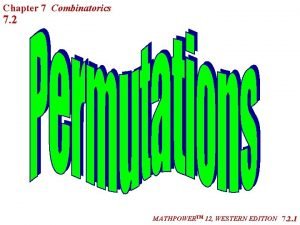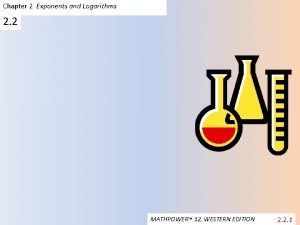Chapter 5 Trigonometric Equations 5 5 MATHPOWERTM 12

















![Applying Skills to Solve a Problem [cont’d] b) Find the distance when the initial Applying Skills to Solve a Problem [cont’d] b) Find the distance when the initial](https://slidetodoc.com/presentation_image_h2/73d29f70197d13870b4eaa8b12d3af56/image-18.jpg)

- Slides: 19

Chapter 5 Trigonometric Equations 5. 5 MATHPOWERTM 12, WESTERN EDITION 5. 5. 1

Sum and Difference Identities sin(A + B) = sin A cos B + cos A sin B sin(A - B) = sin A cos B - cos A sin B cos(A + B) = cos A cos B - sin A sin B cos(A - B) = cos A cos B + sin A sin B 5. 5. 2

Simplifying Trigonometric Expressions 1. Express cos 1000 cos 800 + sin 800 sin 1000 as a trig function of a single angle. This function has the same pattern as cos (A - B), with A = 1000 and B = 800. cos 100 cos 80 + sin 80 sin 100 = cos(1000 - 800) = cos 200 2. Express as a single trig function. This function has the same pattern as sin(A - B), with 5. 5. 3

Finding Exact Values 1. Find the exact value for sin 750. Think of the angle measures that produce exact values: 300, 450, and 600. Use the sum and difference identities. Which angles, used in combination of addition or subtraction, would give a result of 750? sin 750 = sin(300 + 450) = sin 300 cos 450 + cos 300 sin 450 5. 5. 4

Finding Exact Values 2. Find the exact value for cos 150 = cos(450 - 300) = cos 450 cos 300 + sin 450 sin 300 3. Find the exact value for 5. 5. 5

Using the Sum and Difference Identities Prove L. S. = R. S. 5. 5. 6

Using the Sum and Difference Identities x=3 r=5 r 2 = x 2 + y 2 = r 2 - x 2 = 5 2 - 32 = 16 y=± 4 5. 5. 7

Using the Sum and Difference Identities A x y r 2 3 B 4 3 5 5. 5. 8

Double-Angle Identities The identities for the sine and cosine of the sum of two numbers can be used, when the two numbers A and B are equal, to develop the identities for sin 2 A and cos 2 A. sin 2 A = sin (A + A) cos 2 A = cos (A + A) = sin A cos A + cos A sin A = cos A - sin A = 2 sin A cos A = cos 2 A - sin 2 A Identities for sin 2 x and cos 2 x: sin 2 x = 2 sin x cos 2 x = cos 2 x - sin 2 x cos 2 x = 2 cos 2 x - 1 cos 2 x = 1 - 2 sin 2 x 5. 5. 9

Double-Angle Identities Express each in terms of a single trig function. a) 2 sin 0. 45 cos 0. 45 sin 2 x = 2 sin x cos x sin 2(0. 45) = 2 sin 0. 45 cos 0. 45 sin 0. 9 = 2 sin 0. 45 cos 0. 45 b) cos 2 5 - sin 2 5 cos 2 x = cos 2 x - sin 2 x cos 2(5) = cos 2 5 - sin 2 5 cos 10 = cos 2 5 - sin 2 5 Find the value of cos 2 x for x = 0. 69. cos 2 x = cos 2 x - sin 2 x cos 2(0. 69) = cos 2 0. 69 - sin 2 0. 69 cos 2 x = 0. 1896 5. 5. 10

Double-Angle Identities Verify the identity L. S = R. S. 5. 5. 11

Double-Angle Identities Verify the identity L. S = R. S. 5. 5. 12

Double-Angle Equations p 2 p y = cos 2 A 5. 5. 13

Double-Angle Equations y = sin 2 A 5. 5. 14

Using Technology Graph the function and predict the period. The period is p. Rewrite f(x) as a single trig function: f(x) = sin 2 x 5. 5. 15

Identities Prove L. S. = R. S. 5. 5. 16

Applying Skills to Solve a Problem The horizontal distance that a soccer ball will travel, when kicked at an angle q, is given by , where d is the horizontal distance in metres, v 0 is the initial velocity in metres per second, and g is the acceleration due to gravity, which is 9. 81 m/s 2. a) Rewrite the expression as a sine function. Use the identity sin 2 A = 2 sin A cos A: 5. 5. 17
![Applying Skills to Solve a Problem contd b Find the distance when the initial Applying Skills to Solve a Problem [cont’d] b) Find the distance when the initial](https://slidetodoc.com/presentation_image_h2/73d29f70197d13870b4eaa8b12d3af56/image-18.jpg)
Applying Skills to Solve a Problem [cont’d] b) Find the distance when the initial velocity is 20 m/s. From the graph, the maximum distance occurs when q = 0. 785398. The maximum distance is 40. 7747 m. The graph of sin q reaches its maximum when Distance Sin 2 q will reach a maximum when Angle q 5. 5. 18

Suggested Questions: Pages 272 -274 A 1 -16, 25 -35 odd B 17 -24, 37 -40, 43, 47, 52 5. 5. 19
 Tan 240⁰
Tan 240⁰ 5-3 solving trigonometric equations
5-3 solving trigonometric equations Inverse circular functions
Inverse circular functions 5-3 solving trigonometric equations
5-3 solving trigonometric equations Solving linear trigonometric equations
Solving linear trigonometric equations Cos² 45ᵒ + 2 . cos 60ᵒ + sin² 45ᵒ adalah
Cos² 45ᵒ + 2 . cos 60ᵒ + sin² 45ᵒ adalah Trig equations
Trig equations Trigonometric identity
Trigonometric identity Trigonometric equations formulas
Trigonometric equations formulas Chapter 6 trigonometric functions
Chapter 6 trigonometric functions Chapter 4 trigonometric functions
Chapter 4 trigonometric functions Sin cos tan finger
Sin cos tan finger Chapter 5 trigonometric functions
Chapter 5 trigonometric functions Chapter 4 trigonometric functions
Chapter 4 trigonometric functions Algebra 2 quiz 13
Algebra 2 quiz 13 Polar and rectangular forms of equations
Polar and rectangular forms of equations Translating chemical equations
Translating chemical equations Trigonometry basics
Trigonometry basics Trig ratio maze
Trig ratio maze Tangent ratio worksheet
Tangent ratio worksheet
